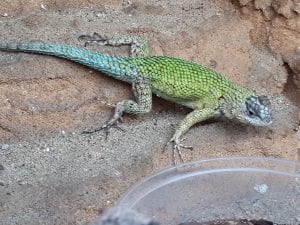When I was a child, over forty years ago I kept wild caught Sceloporus lizard species. They were commonly offered for sale, and were more often than not the spiny desert species originating from the USA. They were often sold as Fence lizards, and almost always kept as a desert species, no matter what their requirements consisted of. I cannot remember if this central American species was available, I don’t think it was, but certainly it’s reputation of being a difficult captive will likely originate from keeping them too dry and hot.
 Emerald swifts (Sceloporus malachitus) come from Mexico and further into Central America. Their habitat is quite specific, they occur in high elevation cloud forest – it’s quite cool and humid. Keeping them hot, as for example a Bearded Dragon, will be unnatural for them and of course adding a dry atmosphere will only add to their struggles to survive. However if they are kept correctly they are an easy species to maintain, certainly no more difficult than other lizard species which occur throughout the world in similar terrain such as Mountain Horned dragons (Acanthosaura capra).
Emerald swifts (Sceloporus malachitus) come from Mexico and further into Central America. Their habitat is quite specific, they occur in high elevation cloud forest – it’s quite cool and humid. Keeping them hot, as for example a Bearded Dragon, will be unnatural for them and of course adding a dry atmosphere will only add to their struggles to survive. However if they are kept correctly they are an easy species to maintain, certainly no more difficult than other lizard species which occur throughout the world in similar terrain such as Mountain Horned dragons (Acanthosaura capra).
Housing would be best catered for in a water resistant vivarium such as a glass terrarium, the more usual melamine chipboard vivaria can be used but the life span will not be long due to the regular spraying this species requires. They are a semi-arboreal (some would say fully arboreal) species, so a tall vivarium would be required – we would suggest an absolute minimum of a four feet long, two feet tall vivarium – with at least half as tall again being preferable. This would house a pair, they are not a large species at around 20cm long (full length). They are fast moving, so be careful when choosing a vivarium, a sliding door design will always be more suitable as the door opening gap can be quite small to deter mad dash escapes.
Décor should be provided to allow natural behaviour. This is where the taller vivarium is needed, as the aim is to create micro-habitats within the vivarium. This allows for thermo-regulation and stress-regulation and of course allows for enrichment to encourage natural behaviour. Branches at various levels, combined with real or artificial plants will provide this adequately – don’t forget that the use of cork bark will also provide shade as well as climbing provision. A water bowl should be provided. Floor substrate can be orchid bark, for those that are aiming to create a natural planted terrarium the various terrarium planting soils work well too, often combined with leaf litter.
Heating can be a debatable topic these days. The important thing to remember is that all heat sources available today are compromised, none are very natural in the way they perform, and what one style of heater does well, it also fails elsewhere. So, whether you choose a ceramic heater, filament or halogen they will all work sufficiently well to maintain Swifts very well indeed. My own choice for this species would be a ceramic heater as they allow for independent control of heat and light – this species doesn’t tolerate cool night time temperatures and the non-visible light caters for this at night. Daytime temperatures need to simulate a high altitude cloud forest, most of the vivaria needs to be around mid 20C, but with a localised basking hot spot of around 28-30C. This can be created with the various micro-habitats created within the vivarium (various levels of branches and shaded areas). Night time temperatures should not drop below around 20-22C. A thermostat must be used, and there are plenty that will automatically provide altering temperatures for day and night, and also switch lighting off automatically too (keeping lighting and heating provision separate also facilitates an easy subtle gentle decrease of temperature in the evening by switching the heating off earlier than the lighting).
Lighting is a very important aspect for this species. Again, nothing can fully come close to what the sun provides, there will be compromise, but with recent developments within the reptile lighting industry there are some preferable lights to provide. I cannot whole heartedly suggest using mercury vapour nor metal halide in such a small vivarium. I would recommend T5 fluorescent reptile tubes, depending on the height and planting of the vivarium I would suggest a minimum of 7{cb5d0a8cf0c44aef2db327d9ab0dba08dd09aed1126b509e5fa01d3aaa87fe47}, and certainly no higher than 12{cb5d0a8cf0c44aef2db327d9ab0dba08dd09aed1126b509e5fa01d3aaa87fe47} UVB. Mount the tube in the roof of the vivarium. If my instruction has been followed in the vivarium décor design, the various branches and shade areas (plants, cork bark etc) will provide a choice of light and UVB level for the Swifts.
Diet is insectivorous, a wide variety of commercially available insects, supplemented with a good quality calcium and multi-vitamin supplement will suffice. Please see our separate guidance on this topic. However, there is a growing movement towards a more natural diet by providing collected insects from safe wild areas (away from pesticides etc). Certainly when I started keeping reptiles and amphibians there was virtually no commercially available insects apart from mealworms for the wild birds – meadow sweeps and log lifting was a common way of collecting insects to feed your animals.
